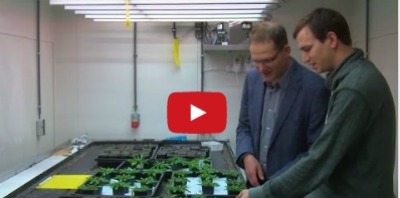
Features
Lighting
Structures & Equipment
LEDs can significantly reduce energy consumption
November 3, 2014 By Dave Harrison

Nov. 3, 2014, Wageningen, the Netherlands — With the exception of energy consumption where there is still much to be done, the Dutch are global leaders in greenhouse horticulture.
The quality is high, and nowhere else is the use of water and pesticides so low. Even so, demand for innovation, sustainable production and healthy fruit and vegetables and high-quality flowers remains high.
One innovation that would really help in this is the introduction of LED lighting in the greenhouse horticulture sector, said Prof. Leo Marcelis, Professor in Horticulture and Product Physiology at Wageningen University. The horticulture sector is important to the Dutch economy, as the export value of horticultural products currently totals about 16 billion euros.
The Dutch greenhouse horticultural sector in particular is a global leader; it is highly innovative and constantly searching for new, applicable knowledge.
Although production has remained more or less constant in the Netherlands, globally the demand for highly controlled production will result in an increase in greenhouse cultivation, said Prof. Marcelis in his inaugural speech entitled, “Horticultural Science in the Spotlight: Exploring and Exploiting the Physiology of Plants.”
Prof. Marcelis believes that the sector needs to become more sustainable and aim to contribute to feeding the world population with high-quality, healthy products.
Scientifically, the sector needs to focus primarily on the high-precision control of the growing process. This will require system innovations: to further reduce the use of resources such as water and minerals, to increase production per unit area, and to obtain the high-quality, healthy products that consumers want.
The scientific focus of Marcelis and his group is on how physiological processes in crops, plants and plant organs respond to environmental conditions during plant cultivation and post-harvest, and how these affect crop production and product quality. Marcelis believes it is important that the horticultural sector focuses not just on growing plants, but also on the handling of products following their harvest.
Currently, about one third of all products are lost in this phase, a figure which he believes can be reduced by 50 per cent.
ENERGY CONSUMPTION
With the exception of energy consumption, the Dutch greenhouse horticulture sector is highly efficient, said Marcelis.
Production levels are extremely high, most pests and diseases are controlled biologically and water and nutrients are largely recycled. For example, it takes 15 litres of water to produce a kilo of tomatoes in a Dutch greenhouse, compared with 60 litres in the open air in the Mediterranean region.
Unfortunately, energy consumption in the Dutch horticulture sector is still very high, and is in fact responsible for 10 per cent of the national gas consumption. Energy costs account for 15 to 30 per cent of the total costs for a horticultural farm, which is why the sector is trying so hard to achieve energy savings.
INCREASED LIGHTING DEMANDS
As Marcelis explained, it is not heat production that is the problem, “the problem is the energy needed for lighting, and light is the driving force behind plant growth.”
He and his group are strong advocates of LED lighting in greenhouse horticulture, and he estimates that the smart use of LEDs can achieve energy savings of up to 50 per cent.
LEDs also have other benefits compared with the lights currently used (high pressure sodium lights), such as the ability to change the colour of the light, the position of the light source in relation to the plant and the intensity of the light. This would enable lighting to be used much more efficiently, resulting in better plant growth and a higher quality product.
Click here to view a video feature on this focus of research by Prof. Marcelis.
Print this page